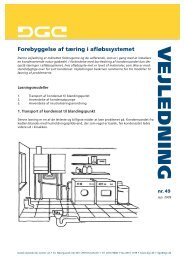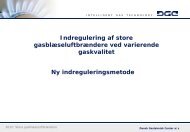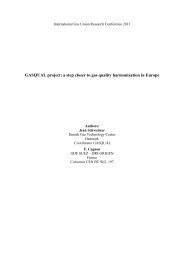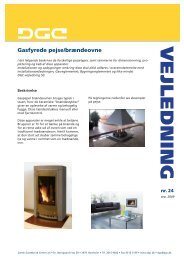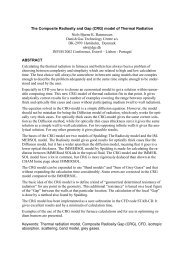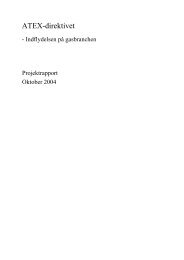Algorithm for methane number determination for natural gasses
Algorithm for methane number determination for natural gasses
Algorithm for methane number determination for natural gasses
You also want an ePaper? Increase the reach of your titles
YUMPU automatically turns print PDFs into web optimized ePapers that Google loves.
<strong>Algorithm</strong> <strong>for</strong> <strong>methane</strong> <strong>number</strong><br />
<strong>determination</strong> <strong>for</strong> <strong>natural</strong> <strong>gasses</strong><br />
Project Report<br />
June 1999
<strong>Algorithm</strong> <strong>for</strong> <strong>methane</strong> <strong>number</strong> <strong>determination</strong> <strong>for</strong> natura!<br />
<strong>gasses</strong><br />
Paw Andersen<br />
Danish Gas Tecbnology Centre a/s<br />
Hørsholm 1999
Title<br />
Report<br />
Category<br />
Author<br />
Date of issue<br />
Copyright<br />
FileNumber<br />
Project Naroe<br />
ISBN<br />
Algorithin <strong>for</strong> roethane <strong>number</strong> deterl)lination <strong>for</strong> <strong>natural</strong> <strong>gasses</strong><br />
Project Report<br />
Paw Andersen<br />
03-06-99<br />
Danish Gas Technology Centre a/s<br />
719.45; \\DATASERVER\PROJ\719\45\Report\02-Project Report.doc<br />
719.45 <strong>Algorithm</strong> <strong>for</strong> roethane nurober <strong>determination</strong> <strong>for</strong> <strong>natural</strong> <strong>gasses</strong><br />
87-7795-125-5<br />
Forservices ofany kind rendered by Danish Gas Teclmology Centre a/s (DGC) thefollowing conditions shall apply<br />
• DGC shall be liable in accordance with "Almindelige Bestemmel er <strong>for</strong> teknisk Rådgivning og bisra.rul, ABR 89"<br />
(''General Conditions <strong>for</strong> Consulting Services (ABR 89)"), which are considered adoptedjor the assignment.<br />
• DGC's liability per error and negligence and damages suffered by the client or an.y third party is limited to<br />
l 00% o f the fee received by DGC <strong>for</strong> the respective assignment. The client shall indemnify and hold DGC<br />
harmless against all losses, expenses and claims which may exceed the liability of DGC.<br />
• DGC shall - without limitarion - re-pei<strong>for</strong>m its own services in comzection with en·ors and negligences cof!lained<br />
in the material delivered to the client by DG C.<br />
This repart is copyright, and must not be reproduced in whole or in part without the prior written consent ofDGC.<br />
This Englis h translation is provid ed <strong>for</strong> convenience only and in case of discrepancy t h e Danis h wording s hall be<br />
applicable.<br />
July 1997
DGC-report 1<br />
Table of Contents<br />
Page<br />
l Introduetion ............................. .......... ............ .. ... ....................................................... ........... 2<br />
2 Description of the algorithm ................................................................................................. 3<br />
2.1 Background- the AVL studies ........................................................................................... 3<br />
2. 1.1 The AVL n1ethod ...... .................................................................................................. 5<br />
2.2 The algorithn1 ................................................................ ...................................................... 6<br />
2.2.1 Calculation of the <strong>methane</strong> <strong>number</strong> without inert gasse . ........................................... 7<br />
2.2.2 Cerreetion <strong>for</strong> inert gas es, C0 2 and N 2 ........................... .......................................... 8<br />
2.2.3 irnits o f the algorithrn ............................................................................................... 9<br />
2.3 Uncertainties ..................................................................................................................... 11<br />
3 Results ................................................................................................................................ 12<br />
4 Conclusion ........................................................................................................................ 17<br />
5 References .......................................................................................................................... 18<br />
Appendices<br />
Al Princip le <strong>for</strong> calculating the ruethane <strong>number</strong> of naturaJ <strong>gasses</strong> ....................................... 19<br />
A2 Prediction principle of roethane <strong>number</strong>s <strong>for</strong> a <strong>natural</strong> gas step by tep ........................... 22
DGC-report 2<br />
1 Introduetion<br />
So far, DGC has calculated the roethane <strong>number</strong> <strong>for</strong> the Danish natura} gas<br />
quality using an algorithm developed by DGC. Since the introduetion of gas<br />
from the Harald field and the ensuing changes to the Danish natura} gas<br />
composition, the sphere of application of the algorithm has been exceeded.<br />
This report describes a new algorithm <strong>for</strong> <strong>determination</strong> of the roethane<br />
<strong>number</strong> <strong>for</strong> natura! <strong>gasses</strong>.<br />
On the basis of the new algorithm a program has been developed to<br />
calculate the roethane <strong>number</strong>. The program together withauser manual can<br />
be requested from Danish Gas Technology Centre.<br />
Per Gravers Kristensen, DGC, has developed the new algorithm and J an<br />
Jensen, DGC, has per<strong>for</strong>med quality assurance of the report.<br />
Hørsholm, June 1999<br />
~~<br />
Paw Andersen<br />
Project Manager
DGC-report 3<br />
2 Description of the algorithm<br />
There is no present standard <strong>for</strong> determining the <strong>methane</strong> <strong>number</strong> <strong>for</strong> gas<br />
mixtures. Nevertheless, practically most of the recent work with <strong>gasses</strong><br />
tendency <strong>for</strong> knocking refer to the very profound studies per<strong>for</strong>med at AVL<br />
in the late sixties /1/. This new algorithm is also basedon these AVL studies.<br />
2.1 Background - the AVL studies<br />
In the AVL w ork a test en gine o f the same type as the en gines used <strong>for</strong><br />
octane <strong>number</strong> <strong>determination</strong> was used to determine the <strong>gasses</strong>' relative<br />
tendency <strong>for</strong> knocking. As <strong>for</strong> petrol's octane <strong>number</strong> /2/, /3/ the scale <strong>for</strong><br />
the <strong>gasses</strong> is relative. The definitions are that pure <strong>methane</strong> has a <strong>methane</strong><br />
<strong>number</strong> o f l 00 and pure hydrogen has a <strong>methane</strong> <strong>number</strong> o f O.<br />
The AVL study Il/ ineludes the components CH4, C2H4, C~6, C3H6, C3Hs,<br />
n-C4H10, H2, C02, N2 and H2S in binary and temary comperrent mixtures. In<br />
addition, some measurements have been made <strong>for</strong> a lirnited <strong>number</strong> of<br />
<strong>natural</strong> <strong>gasses</strong>. Frimarily all the AVL Il/ data are available as temary<br />
diagrams, as shown in Pigure 2.1 and Pigure 2.2. For further in<strong>for</strong>mation on<br />
the AVL studies see 111.
DGC-report<br />
4<br />
CFR IRDH-MOTOR<br />
n·900U/min .• ~y·15°KWv.OT<br />
'11.•1, ts•25-30°C, tw-80°C -Methanzahi-Linien(%Cf4)<br />
Klopfstiirke K/• 50• konstant<br />
Pigure 2.1. Methane <strong>number</strong> diagram<strong>for</strong> <strong>methane</strong>, ethane and butane Il/<br />
CFR/RDH-MOTOR<br />
n=900U/min. ct.·1SOKWv.OT<br />
')...f, ts •25-30°C, fw·B0°C - Methanzahi-Linien(%Cf4)<br />
Klopfsti:irke K/•50 •konstant<br />
Pigure 2.2. Methane <strong>number</strong> diagram<strong>for</strong> <strong>methane</strong>, propane and butane Il/
DGC-report 5<br />
2.1.1 The AVL method<br />
From all the experimental results, a procedure was developed to predict the<br />
<strong>methane</strong> <strong>number</strong> of a <strong>natural</strong> gas using the chemical composition of the gas.<br />
The procedure is:<br />
l. The main components of the gas are determined. Inert <strong>gasses</strong> (C0 2 and<br />
N2) are neglected at first.<br />
2. The reduced gas (no inert <strong>gasses</strong>) is converted to 100% by volume.<br />
3. The resulting mixture is divided into two fractions.<br />
4. These two fractions are again normalised in to l 00% by volume.<br />
5. The <strong>methane</strong> <strong>number</strong> of each o f the two mixtures is determined using<br />
the diagrams.<br />
6. lf the difference between the two <strong>methane</strong> <strong>number</strong>s found is greater than<br />
five, go back to step 3 and try again with two new fractions. When the<br />
difference is smaller than five, the <strong>methane</strong> <strong>number</strong> <strong>for</strong> the mixture<br />
without inert <strong>gasses</strong> can be determined using (Eq. 2.1).<br />
n<br />
MN'= 1 6o·LY; ·MN; (Eq. 2.1)<br />
i=l<br />
Where:MN' is the <strong>methane</strong> <strong>number</strong> <strong>for</strong> the gas free of inert <strong>gasses</strong><br />
MN; is the <strong>methane</strong> <strong>number</strong> of component group i<br />
Y; is the share of component group i in the total mixture in percentage<br />
by volume<br />
7. Finally, the influence from the inert <strong>gasses</strong> (MN") has to be taken into<br />
account. The influence from C02 and N2 is found by using the diagram<br />
shown in Pigure 2.3, where the total share of gas not containing inert<br />
<strong>gasses</strong> is considered as <strong>methane</strong>. In the AVL procedure the inert <strong>gasses</strong><br />
C0 2 and N 2 are neglected, if their volume concentrations do not exceed<br />
two and nine percent, respectively.<br />
8. The total <strong>methane</strong> <strong>number</strong> can then be determined by adding MN' and<br />
MN".
DGC-report 6<br />
CFR /RDH-MOTOR<br />
n-900 Uhnin, «.t-15'KWv.OT<br />
'A-1. tL·20'C. t.·25-30'C, tvrBO'C<br />
Klopfstiirke K /.SO-konstant<br />
-- Methanzahi-Linien (%CH,)<br />
Figure 2.3. Methane <strong>number</strong> diagram<strong>for</strong> <strong>methane</strong>, carbon dioxide and nitrogen<br />
2.2 The algorithm<br />
As previous menticned the new DGC algorithm is based on the AVL studies.<br />
The new algorithm also determines the <strong>methane</strong> <strong>number</strong> (MN) <strong>for</strong> a gas<br />
in two steps. First, the <strong>methane</strong> <strong>number</strong> <strong>for</strong> the gas free of inert <strong>gasses</strong> is<br />
determined, then the contribution from the inert <strong>gasses</strong>. Finally, the total<br />
<strong>methane</strong> <strong>number</strong> is found as:<br />
MN = MN Without inen <strong>gasses</strong> + MNinen <strong>gasses</strong> (Eq. 2.2)<br />
Where:MN is the total <strong>methane</strong> <strong>number</strong><br />
MNwithout inert <strong>gasses</strong> is the <strong>methane</strong> <strong>number</strong> of the gas free of inert <strong>gasses</strong><br />
MNrnert <strong>gasses</strong> is the supplement to the total <strong>methane</strong> <strong>number</strong> from the<br />
inert <strong>gasses</strong><br />
Below follows a description of the assumptions made in the algorithm, and<br />
how the <strong>methane</strong> <strong>number</strong> is actually calculated.
DGC-report 7<br />
2.2.1 Calculation of the <strong>methane</strong> <strong>number</strong> without inert <strong>gasses</strong><br />
To cover as large a spectrum as possible of the most common <strong>natural</strong> <strong>gasses</strong>,<br />
the two temary AVL diagrams shown in Figure 2.1 and Figure 2.2 are<br />
used as the basis <strong>for</strong> determining the <strong>methane</strong> <strong>number</strong> <strong>for</strong> the gas free of<br />
inert <strong>gasses</strong>.<br />
The <strong>for</strong>mulaes developed to calculate the <strong>methane</strong> <strong>number</strong> are based on the<br />
assumption that the <strong>methane</strong> <strong>number</strong> curves in Figure 2.1 and Figure 2.2 can<br />
be represented as straight lines.<br />
Normally, <strong>natural</strong> <strong>gasses</strong> contain <strong>methane</strong>, ethane, propane, butane, pentane,<br />
hexane and higher hydrocarbons, carbon dioxide, nitrogen and hydrogen<br />
sulphide etc. Because the ALV /1/ study does not inelude higher hydrocarbons<br />
than n-CiHIO, all hydrocarbons higher than C3Hs are calculated as n<br />
C4HIO. The content of hydrogen sulphide in Danish <strong>natural</strong> gas is normally<br />
very low and is, there<strong>for</strong>e, neglected. Then the gas is represented as<br />
G(X1, X2, X3, X4) where X1 is the CH4 concentration, X2 is the C~6 concentration,<br />
X3 is the C3H 8 concentration and X4 is the concentration of n<br />
C4H10, i-C4H10 and higher hydrocarbons. Then, using the assumption that<br />
the <strong>methane</strong> <strong>number</strong> curves in Figure 2.1 and Figure 2.2 can be represented<br />
as straight lines, we have:<br />
A: (XIA ,X2A' O,X4A): MN=AB<br />
B: (X 18 ,X 28 , o,X 48 ): MN=AB<br />
C: (X1c ,O,X 3 c ,X4c): MN=CD<br />
D: (Xw ,O,X 3 v ,X 4 v): MN=CD<br />
(Eq. 2.3)<br />
Where A is the starting point of the MN curve in CH4, C2H6, C4H10 diagram<br />
B is the ending point of the MN curve in CH4, C2H6, C4H 10 diagram<br />
C is the starting point ofthe MN curve in CH4, C1Hs, C4H10 diagram<br />
D is the ending point of the MN curve in CH4, C 3 H 8 , C4H10 diagram<br />
X1 * is the concentration of CH4<br />
X2* is the concentration of C2H6<br />
X 3 * is the concentration of C1Hs<br />
X 4 * is the concentration of C 4 H 10
DGC-report<br />
8<br />
Generating two mixtures: E, a mixture of A and B, and F, a mixture of C<br />
and D:<br />
E: E AB<br />
F: E BC<br />
Parameter a<br />
Parameter f3<br />
(Eq. 2.4)<br />
Mixing our gas G(X 1 , X 2 , X 3 , X 4 ) as fractions ofE and F we obtain:<br />
G=X ·E+(l-X)·F<br />
(Eq. 2.5)<br />
and<br />
MN(G)=MN(E)+X ·[MN(F)-MN(E)]<br />
(Eq. 2.6)<br />
where:<br />
MN(E)=AB<br />
MN(F)=CD<br />
(Eq. 2.7)<br />
Solving this <strong>for</strong> X, gives the general solution shown in (Eq. 2.6). In Appendix<br />
Al the derivation of (Eq. 2.6) is given.<br />
x 1<br />
x2A x LB- x28 x,A -X2 (X w -X lA) x3 (X ID - X,c)<br />
X2A - X2B<br />
X 3D - X3c<br />
x (Eq. 2.8)<br />
X 3D -X3c<br />
X2A -X2B<br />
2.2.2 Cerreetion <strong>for</strong> inert <strong>gasses</strong>, C02 and N2<br />
As previously mentioned, inert <strong>gasses</strong> increase the <strong>methane</strong> <strong>number</strong>. The<br />
only inert <strong>gasses</strong> that are taken into account are C0 2 and N 2 . To determine<br />
the contribution from the inert <strong>gasses</strong> C0 2 and N 2 , the AVL diagram shown<br />
in Figure 2.3 is used. It has been found that the increased knocking resistance<br />
due to C0 2 and N 2 can be calculated using a tertiary interpolation expression<br />
o f the <strong>for</strong>m:
DGC-report<br />
9<br />
MZC02&N2 =100-<br />
[%CH 4<br />
p ·R 111 + [%CHJ 2 · [%C0 2 ].R 112<br />
+<br />
[%CHJ 2 · [%Nzl.R 113 +<br />
[%CHJ· [%C02] 2 ·R12z +<br />
[%CHJ· [%COzl[%NJ·R 123 +<br />
[%CH 4 ] • [%Nz] 2 ·R 133<br />
+<br />
[%COz] 3 ·R222 + [%COz] 2 · [%Nz].Rzz3 +<br />
[%coJ [%Nz] 2 ·Rz33 +[%N z P Rm +<br />
[%CHJ 2 ·R 11<br />
+ [%CH 4<br />
]. [%C0 2 ].R 12 +<br />
[%CHJ [%N2].R 13<br />
+ [%C02] 2 ·R 22 +<br />
[%C0 2 ].[%N 2 ].R 23 + [%N 2 ] 2 ·R 33 +K<br />
(Eq. 2.9)<br />
Where:MNc02&N2 is the increase in the <strong>methane</strong> <strong>number</strong> caused by C02 and<br />
N2<br />
%CH4 is the cantent af CH4, C2H6, C3Hs, C~w in valurne<br />
percentage af the gas<br />
%C02 is the cantent af C02 in valurne percentage af the gas<br />
%N2 is the cantent af N2 in valurne percentage af the gas<br />
RnJ. Rn2, Rn3, Rn2, Rn3, Rn3, R222, R223, R233, R333, Rn. Rn, Rn,<br />
R22, R23, R33 and K are canstants where:<br />
Rw = 52.25 , Rn2 = 148.40 ,<br />
Rn2 = 18.68 , R123 = -237.05 ,<br />
R222 = 48.33 , R223 = 64.18 ,<br />
R333 = -190.89 , R 11 = 29.69 ,<br />
Rn = 161.54 , R22 = 158.93 ,<br />
R33 = 302.83 , K = 18.06<br />
2.2.3 Limits of the algorithm<br />
Rn3 =<br />
Rn3 =<br />
R233 =<br />
Rl2 =<br />
R23 =<br />
153.84<br />
9.03<br />
440.32<br />
102.83<br />
517.88<br />
The available data that provides the basis <strong>for</strong> the algorithm also provides the<br />
limits of the algorithm. The calculations can only be made <strong>for</strong> <strong>gasses</strong> with a<br />
<strong>methane</strong> <strong>number</strong> higher then 45 (without inert <strong>gasses</strong>). The concentration of<br />
C0 2 eannot be higher than 30 v ol% and the concentration o f N 2 eannot be<br />
higher than 50 vol%. In Figure 2.4- Figure 2.7 the limits of the calculation<br />
of the <strong>methane</strong> <strong>number</strong> without inert <strong>gasses</strong> are shown.
DGC-report<br />
10<br />
~ 95 +--!---+---+----+--=<br />
'#.<br />
~ 90 +--1---::<br />
Q)<br />
c<br />
ro<br />
L: 85<br />
(j)<br />
2<br />
80<br />
75<br />
40 45 50 55 60 65 70 75 80 85 90 95 100 105<br />
Methane <strong>number</strong><br />
Figure 2.4. The possible <strong>methane</strong> concentrations in the new algorithm as a<br />
function of the <strong>methane</strong> <strong>number</strong><br />
5<br />
o<br />
40 45 50 55 60 65 70 75 80 85 90 95 100 105<br />
Methane <strong>number</strong><br />
Figure 2.5. The possible ethane concentrations in the new algorithm as a<br />
function of the <strong>methane</strong> <strong>number</strong>
DGC-report<br />
11<br />
~ 20<br />
~<br />
Q) 15<br />
c<br />
ro<br />
c.<br />
~ 10<br />
5<br />
o<br />
40 45 50 55 60 65 70 75 80 85 90 95 100 105<br />
Methane <strong>number</strong><br />
Figure 2.6. The possible propane concentrations in the new algorithm as a<br />
function of the <strong>methane</strong> <strong>number</strong><br />
16<br />
14<br />
~<br />
o<br />
2:.<br />
Q)<br />
c<br />
ro<br />
.....<br />
:J<br />
m<br />
l<br />
c<br />
12<br />
10<br />
8<br />
6<br />
4<br />
40 45 50 55 60 65 70 75 80 85 90 95 100 105<br />
Methane <strong>number</strong><br />
Figure 2.7. The possible n-butane (and higher hydrocarbons) concentrations<br />
in the new algorithm as a function of the <strong>methane</strong> <strong>number</strong><br />
2.3 Uncertainties<br />
The uncertainties on the <strong>methane</strong> <strong>number</strong> of the AVL studies are ±2 Il/.<br />
From the test of the new algorithm, see Chapter 3, it is found that the new<br />
algorithm in the worst case differs 1.03 from the AVL data. Renee it can be<br />
concluded that the uncertainty o f the new algorithm is approximately ±3.
DGC-report 12<br />
3 Results<br />
The error between readings in Figure 2.1 and calculated <strong>methane</strong> <strong>number</strong> of<br />
the responding gas is shown in Figure 3 .1. The maximum error is les s than<br />
0.8. The error varies from -0.9% to 0.3%.<br />
0.4<br />
0.2<br />
o<br />
....<br />
o<br />
.... -0.2<br />
•<br />
w<br />
-0.4 •<br />
•<br />
-0.6<br />
• • • •<br />
•<br />
•<br />
• •<br />
•<br />
-0.8 •<br />
40 50 60 70 80 90 100<br />
Methane <strong>number</strong> Mz<br />
Figure 3.1. Error between readings in Pigure 2.1 and calculated <strong>methane</strong><br />
<strong>number</strong>s<br />
The error between readings in Figure 2.2 and calculated <strong>methane</strong> <strong>number</strong> of<br />
the responding gas is shown in Figure 3.2. The maximum error is 1.03. The<br />
error varies from -0.6% to 2.2%.<br />
1.2<br />
1<br />
0.8<br />
0.6<br />
....<br />
o 0.4<br />
....<br />
w 0.2<br />
o<br />
-0.2<br />
-0.4<br />
•<br />
:<br />
• •<br />
•<br />
• • å<br />
• • •<br />
t<br />
• : • • • t •<br />
• • •<br />
~ : • • •<br />
• ..<br />
.....<br />
•<br />
• t •<br />
l<br />
• • •<br />
-0.6<br />
40 50 60 70 80 90 100<br />
Methane <strong>number</strong> Mz<br />
Figure 3.2. Error between readings in Figure 2.2 and calculated <strong>methane</strong><br />
<strong>number</strong>s
DGC-report 13<br />
The above results show that the errors introduced by the assumptions that<br />
the <strong>methane</strong> <strong>number</strong> curves in Figure 2.1 and Figure 2.2 can be represented<br />
as straight lines is very small.<br />
Table 3.1 shows five different gas compositions and their <strong>methane</strong> <strong>number</strong>s<br />
as calculated by AVL Il/ and as calculated by using the new DGC algorithm.<br />
The table shows good agreement between the results.<br />
() () ()<br />
,.<br />
:l<br />
,.<br />
:l () () z :s: :s:<br />
:r<br />
1\)<br />
l l<br />
() ()<br />
.... :r '"' :r .... () ()<br />
1\)<br />
"' +<br />
z z<br />
Ol<br />
<br />
....<br />
~ ~ ~ "' :r<br />
)> o<br />
Ol<br />
o<br />
1\)<br />
o 1\)<br />
o < G)<br />
1\)<br />
r ()<br />
69.00 20.00 11.00 54.80 55.9<br />
65.00 18.50 11.00 5.50 48.25 48.4<br />
96.88 1.42 0.37 0.08 0.10 0.04 0.03 0.04 0.19 0.64 90.65 90.8<br />
97.27 1.17 0.32 0.08 0.09 0.04 0.03 0.18 0.20 0.62 91.3 90.3<br />
95.21 2.47 0.70 0.13 0.19 0.08 0.06 0.23 0.29 0.56 84.8 83.2<br />
Table 3.1. Dif.ferent gas compositions and their respective <strong>methane</strong> <strong>number</strong><br />
calculated by A VUJ/ and the new DGC algorithm<br />
In cernbination with work done in the European Gas Research Group<br />
(GERG), different methods <strong>for</strong> calculating the <strong>methane</strong> <strong>number</strong> have been<br />
compared. In Table 3.2 the results of eight different methods and the new<br />
DGC algorithm are shown <strong>for</strong> a <strong>number</strong> of different European gas qualities.<br />
The table shows a very large variation in the results. There is good agreement<br />
between the new DGC algorithm and method 8. One o f the reasons <strong>for</strong><br />
the small difference between method 8 and the new DGC algorithm is that<br />
method 8 does not take N 2 and C0 2 into account, if the contentis below<br />
9 vol% and 2 vol%, respectively. The new DGC algorithm always takes N 2<br />
and C0 2 into account to keep the continuity.
DG C-re port 14<br />
DGC<br />
- - - - - - - (il N ::E<br />
~N<br />
3: 3: 3: 3: 3: 3: 3: 3: noæ: n 3:<br />
(11 (11<br />
(11 (11 (11 (11 (11<br />
~<br />
S!Oz o o z<br />
:r :r :r :r :r :r :r :r<br />
(11 III<br />
o o o o o o o o O III-·<br />
c. c. c. c. c. c. c. c. -:J- !l :::J<br />
...... N (") .j:lo Ul Ol ..... 00<br />
c;· c. g c;· c.<br />
:J zs:::: :l z<br />
"'- N<br />
Gas 1 84 85 80 82 83 91 81 84.3 83.5 1.0 84.6<br />
Gas 2 72 79 76 77 79 88 70 79.9 76.7 2.9 79.5<br />
Gas 3 85 86 81 83 85 92 82 85.3 84.6 1.6 86.1<br />
Gas 4 78 75 75 73 76 83 73 76.1 73.7 2.6 76.2<br />
Gas 5 73 70 68 70 71 79 69 71.3 68.7 2.9 71.6<br />
Gas 6 82 83 78 80 82 90 82 82.1 80.8 1.7 82.5<br />
Gas 7 66 67 64 63 68 71 68 66.5 68.8 0.0 68.8<br />
Gas 8 75 73 72 70 72 80 73 71.7 72.6 0.2 72.8<br />
Gas 9 79 80 79 77 80 88 75 79.7 78.4 2.5 80.9<br />
Gas 10 81 BO 79 75 78 84 79 78.8 78.8 0.3 79.1<br />
Gas 11 71 84 85 82 86 85 75 87.6 82.5 4.7 87.2<br />
Gas 12 91 93 87 88 90 95 88 90.7 91.8 0.1 91.9<br />
Gas 13 90 93 91 90 91 97 94 91.5 92.1 0.9 93.0<br />
Gas 14 68 68 64 68 64 74 66 63.9 64.4 0.1 64.1<br />
Gas 15 68 67 66 66 66 73 67 65.4 66.3 0.1 66.5<br />
Gas 16 67 87 85 86 90 98 77 92.0 86.0 5.7 91.8<br />
Gas 17 75 77 75 75 78 86 73 77.5 75.8 2.6 78.4<br />
Gas 18 70 80 81 81 85 94 75 88.6 78.6 7.5 86.1<br />
Gas 19 95 99 94 96 99 100 96 96.8 99.2 0.1 99.3<br />
Gas 20 93 96 94 94 95 99 96 94.4 96.0 0.4 96.4<br />
Gas21 84 86 83 83 84 92 81 84.7 83.7 1.6 85.3<br />
Gas 22 67 72 69 70 72 81 68 72.4 70.7 2.0 72.8<br />
Gas23 74 70 71 70 71 79 69 69.0 69.5 1.3 70.7<br />
Gas24 74 73 69 68 71 79 74 72.4 73.0 0.3 73.3<br />
Gas 25 77 76 74 71 75 81 74 75.5 75.8 0.2 76.0<br />
Gas 26 76 75 74 70 74 81 74 74.1 74.7 0.2 74.9<br />
Gas 27 76 74 74 70 74 80 74 73.8 74.4 0.2 74.6<br />
Gas 28 83 83 78 76 81 88 79 82.8 82.3 0.4 82.4<br />
Gas 29 94 98 94 96 96 100 96 96.3 98.7 0.5 99.2<br />
Gas 30 90 98 94 95 98 100 94 96.2 97.4 1.2 98.6<br />
Gas 31 90 93 91 88 89 96 91 90.8 92.2 0.2 92.3<br />
Gas 32 77 76 74 71 75 82 75 75.7 75.8 0.3 76.1<br />
Gas 33 78 84 76 72 76 92 75 84.6 81.8 2.7 84.5<br />
Gas 34 82 85 77 79 78 91 81 83.4 82.4 1.2 83.6<br />
Gas 35 66 70 69 70 71 80 68 71.7 70.0 2.1 72.1<br />
Table 3.2. Methane <strong>number</strong>s of different European gas qualities calculated<br />
by different methods<br />
In Figure 3.3 the new DGC algorithm is compared with the old DGC algorithm<br />
u sin g the data <strong>for</strong> the Danish natura! gas quality from J anuary 1995 to<br />
September 1998. There is very good agreement between the two algorithms<br />
<strong>for</strong> <strong>gasses</strong> with a knocking resistance smaller than approximately 72.5.
DGC-report<br />
15<br />
u 77 .----.----.----.-----.----.----.----.----.--~<br />
o<br />
5<br />
w 76 +----+----~--~----~----~---r----+---~~~<br />
E<br />
s:<br />
~ 75 +-----+------t------l-----t-----1--:<br />
w<br />
.c<br />
-;, 7 4 +----+----~--~----~------c<br />
c<br />
(J)<br />
~ 73 +-----+------t------l-----+-~<br />
~<br />
:J 72 +----+-----t-----l~<br />
u<br />
Cil<br />
u<br />
....<br />
w<br />
.o<br />
5 70 +-----+=<br />
c<br />
w<br />
c<br />
Cll<br />
.c<br />
~ 68 *---~---+----r---~---+----~--~---+--~<br />
68 69 70 71 72 73 74 75 76 77<br />
Melhane <strong>number</strong> calculaled using lhe old melhed<br />
Figure 3.3. The new method versus the old method.<br />
In Pigure 3.3 all the <strong>methane</strong> <strong>number</strong> calculations are shown, whereas<br />
Pigure 3.4 only shows the data where the old algorithm is valid. It is seen<br />
that there are no results <strong>for</strong> <strong>methane</strong> <strong>number</strong>s less than 70.5 after the old<br />
method or 71 after the new method.<br />
u<br />
o<br />
.c<br />
77<br />
Qi 76<br />
E<br />
s:<br />
w<br />
c<br />
w<br />
.c<br />
-;, 74<br />
c<br />
(J)<br />
:J<br />
73<br />
u<br />
.æ<br />
Cll<br />
:J<br />
u<br />
72<br />
Cil<br />
u<br />
.... 71<br />
w<br />
.o<br />
E<br />
:J<br />
c 70<br />
w<br />
c<br />
Cll 69<br />
.c<br />
~<br />
68<br />
68 69 70 71 72 73 74 75 76 77<br />
Melhane <strong>number</strong> calculaled using lhe ol d melhed<br />
Figure 3.4. The new method versus the old method. Only data where the old<br />
algorithm is valid.
DGC-report 16<br />
The ol d algorithm has a tenden c y of underestimating the <strong>methane</strong> <strong>number</strong><br />
<strong>for</strong> <strong>gasses</strong> with a high <strong>methane</strong> <strong>number</strong>. The old algorithm is not valid if the<br />
<strong>methane</strong> <strong>number</strong> of the gas is higher than approximately 79. In Figure 3.5<br />
the possible <strong>methane</strong> concentrations in the old algorithm are shown.<br />
~ 96 +-~--,_~r--r--r--+--+-~--,_~r--r--+--+~<br />
o<br />
2:.<br />
:g 94 +----1---+---J----+---+---+=:::b<br />
ca<br />
.J::.<br />
w<br />
~ 92 +--+---!---:<br />
66 67 68 69 70 71 72 73 74 75 76 77 78 79 80<br />
Methane <strong>number</strong><br />
Figure 3.5. The possible <strong>methane</strong> concentrations in the old algorithm
DGC-report 17<br />
4 Conclusions<br />
The purpose of developing a new algorithm <strong>for</strong> determining the <strong>methane</strong><br />
<strong>number</strong> of natura! <strong>gasses</strong> has been fulfilled. The new algorithm is in good<br />
agreement with the AVL /1/ data, the calculated results only vary<br />
approximately ± l araund the AVL data.<br />
There is good agreement between the old algorithm <strong>for</strong> <strong>gasses</strong> with <strong>methane</strong><br />
<strong>number</strong>s lower than 72.5. The new algorithm gives results that are<br />
approximately 0.5 higher than the old method.<br />
Compared with other methods there is good agreement with some of the<br />
methods. In general, however, there is a very large variation between the<br />
methods.<br />
The new algorithm has some limits given by the available data used as basis<br />
<strong>for</strong> the algorithm. The calculations can only be made <strong>for</strong> <strong>gasses</strong> with a<br />
<strong>methane</strong> <strong>number</strong> higher than 45 (without inert <strong>gasses</strong>). The concentration of<br />
C0 2 eannot be higher than 30 vol%, and the concentration of N 2 eannot be<br />
higher than 50 vol%.
DGC-report 18<br />
5 References<br />
111 Forschungsberichte Verbrennungskraftmaschinen Heft 120, 1997,<br />
'Erweiterung der Energieerzeugung durch Kraftgase, Teil3.<br />
/2/ ASTM D-2699<br />
/3/ ASTM D-2700<br />
/4/ 'Engine knock rating of<strong>natural</strong> gases- Methane <strong>number</strong>', T .J.<br />
Callahan, T.W. Ryan, S.R. King, 93-ICE-18, ASME,1993.<br />
151 'Engine knock rating of natura! gases - expanding the roethane<br />
<strong>number</strong> database', T.J Callahan et al., Jæ-vol27-4, ASME, 1996.<br />
/6/ 'Application of the Waukesha Knock Index Methane <strong>number</strong> <strong>for</strong><br />
rating gaseous fuels', R.J. Selberg, Proceedings of the 22nd CIMAC<br />
conference, 1998.<br />
171 WKI program, Version 1.12, 1998.<br />
/8/ 'Die Klopffestigkeit engineer Gase', P. Ferretti, Kraftstoff 1941.<br />
191 Intemal Combustion Engine Fundamentals, J.B. Heywood, McGraw<br />
Hill1988.<br />
1101 Intemal GERG note 'Natura! Gas Quality on Gas Engines', 1998.<br />
/11/ Draft ISOffC 193/SC N 129 (97-01-15)
DGC-report 19<br />
6 Principle <strong>for</strong> calculating the <strong>methane</strong> <strong>number</strong> of<br />
<strong>natural</strong> <strong>gasses</strong><br />
This Appendix describes how the equation (EQ 2.3) is found.<br />
The gas is represented as G(X1, X2, X3, X4), where X1 is the CH4 concentration,<br />
X2 is the C2H6 concentration, X3 is the C3Hs concentration, and X2 is<br />
the concentration of n-C4H 10 and higher hydrocarbons. Using the assumption<br />
that the <strong>methane</strong> <strong>number</strong> curves in Pigure 2.1 and Pigure 2.2 can be<br />
represented as straight lines we have:<br />
A: (X 1 A ,X2A, o,X4A): MZ=AB<br />
B: (XlB ,X2B' O,X4B): MZ=AB<br />
C: (X 1 c ,O,X 3 c ,X4c): MZ=CD<br />
D: (Xw ,O,X 3 v,X4v): MZ=CD<br />
(Eq A l)<br />
Where A is the starting point ofthe MN curve in CH4, C2H6, C4H1o diagram<br />
B is the ending point ofthe MN curve in CH4, C2H6, C4Hw diagram<br />
C is the starting point ofthe MN curve in CH4, C3Hs,C4Hwdiagram<br />
D is the ending point ofthe MN curve in CH4, C3Hs, C4H10 diagram<br />
X1* is the concentration of CH4<br />
X2* is the concentration of C2H6<br />
X3* is the concentration of C3Hs<br />
X4* is the concentration of C4H1o<br />
Then generating two mixtures E and F<br />
where: E: E AB<br />
F: E CD<br />
parameter a<br />
parameter Ø<br />
where it is valid that:<br />
G=X ·E+(l-X)·F<br />
MZ(G)=MZ(E)+X ·[MZ(F)-MZ(E)]<br />
(Eq A 2)<br />
Settin g:<br />
a<br />
x2<br />
--+X2A<br />
X-1<br />
X2A -X2B<br />
(Eq A 3)
DGC-report<br />
20<br />
and:<br />
x 3 - x<br />
X 3C<br />
f3 = --==---<br />
x 3D -x 3C<br />
(Eq A 4)<br />
then:<br />
(1-a)=<br />
-x - x2<br />
28<br />
(X-1)<br />
X 2A -Xza<br />
(EqA 5)<br />
and:<br />
x 3<br />
-X - -<br />
3D<br />
(1-/3)= x<br />
X 30- X 3C<br />
(EqA 6)<br />
U sing tb e a bove w e get:<br />
(Eq A 7)<br />
Equation (Eq A 7) is solved <strong>for</strong> X by inserting a and ~<br />
x - x3<br />
x3<br />
Jn X X-X3c<br />
X ---XJc+<br />
X 3D -X3C<br />
X 3D -X3C<br />
Xw<br />
(Eq A 8)
DGC-report<br />
21<br />
+<br />
X X -X X X3 (Xw -Xtc)<br />
3D IC 3C ID+ x<br />
x -------------------------<br />
x3D -x3c<br />
(Eq A 9)<br />
(EqA<br />
JO)<br />
~<br />
XI =X[(X3D xlC -X3C Xw) (X2A XIB -X2B xlA)]+<br />
x 3D -x3c<br />
x 2A x IB -x2n x lA -x2<br />
X 2A -x 2 8<br />
x ~M -x2s<br />
cx1s -x lA)+ x3<br />
(XI D -X !C )<br />
X 3D -X 3C<br />
(EqA 11)<br />
x<br />
(EqA 12)<br />
X 3D -X3c
DGC-report 22<br />
7 Prediction principle of <strong>methane</strong> <strong>number</strong>s <strong>for</strong> a <strong>natural</strong><br />
gas step by step<br />
l. The Natural gas analysis is put into a table of the above <strong>for</strong>mat. The H2S<br />
and odorant (THT) are only present in small quantities, and there<strong>for</strong>e not<br />
used in the calculation. The Danish gas is normall y analysedas a C 6 + result.<br />
2. The sum of hydrocarbon components is added up and the <strong>number</strong> is out<br />
into table at the C1+ place. N2 and C02 are kept as be<strong>for</strong>e. The result is<br />
used in cernbination with Pigure A2.3 to finda<strong>methane</strong> <strong>number</strong> addition<br />
due to the content of inert gases (N2 and C02).<br />
3. The C4+ fraction is calculated as the sum o f all C4, C 5 and the C 6 + fraction.<br />
Inert components are not considered.<br />
4. Step 5 to 7 is the most difficult steps to per<strong>for</strong>m, and they are per<strong>for</strong>med<br />
bytrialand error, until an acceptable result is achieved. The aim is to divide<br />
the mixture calculated in step 3 into two new mixtures, called Mix I<br />
andMix II.<br />
5. Put all of the C2H 6 into Mix I, and all the C 3 H 8 into Mix II. The remaining<br />
two components from step 3, CH4 and the C4+ are divided into the<br />
two mixtures, Mix I and Mix II<br />
6. Calculate the relative composition of Mix I and Mix II, as shown in T a<br />
ble A2.2. Read the <strong>methane</strong> <strong>number</strong> <strong>for</strong> Mix I in Pigure 2.1, and the<br />
<strong>methane</strong> <strong>number</strong> <strong>for</strong> Mix II in Pigure A2.2.<br />
7. Compare the obtained <strong>methane</strong> <strong>number</strong>s <strong>for</strong> Mix I and Mix Il. If the<br />
difference is 5 or above, repeat from step 5 again.<br />
8. Find the <strong>methane</strong> <strong>number</strong> <strong>for</strong> the composition determined in step 2 by<br />
the use of Pigure A2.3.<br />
9. Finally calculate the <strong>methane</strong> <strong>number</strong> as shown in Table A2.3 by adding<br />
up the results from Mix I and II using the weight factors, and add the effect<br />
of inert. The result is 70.7 in <strong>methane</strong> <strong>number</strong>.
DGC-report 23<br />
Table A2.1: Calculations <strong>for</strong><strong>methane</strong> <strong>number</strong> <strong>determination</strong>.<br />
Step # l 2 3 5-7 5-7<br />
Components Analys is cl+ and c4+ without Mixi Mixll<br />
volume parts ( average inert inert<br />
of 100 1998)<br />
CH4 88.15 - 88.15 42.50 45.65<br />
c l+ - 98.473<br />
CzH6 6.35 - 6.35 6.35 o<br />
C3Hs 2.77 - 2.77 o 2.77<br />
i-C4H10 0.55 - - - -<br />
n-C4H10 0.41 - - - -<br />
c4+ - - 1.203 0.600 0.603<br />
i-CsH12 0.075 - - -<br />
n-CsH12 0.110 - - - -<br />
c6+ 0.058 - - - -<br />
N z 0.342 0.342 - - -<br />
CO z 1.18 1.18 - - -<br />
Total 99.995 99.995 98.473 49.45 49.023<br />
r, a bl e A2 2 s te p 6 d etm ·z s<br />
Component Mixi Mixll Mixi, Mix II,<br />
relative relative<br />
CH4 42.50 45.65 85.95 93.12<br />
CzH6 6.35 0.00 12.84 0.00<br />
C3Hs 0.00 2.77 0.00 5.65<br />
c4+ 0.600 0.603 1.21 1.23<br />
Total 49.45 49.023 100.00 100.00<br />
Methane <strong>number</strong> (MN) from Pigure 70 69<br />
2.1 and Pigure 2.2<br />
T, a bl e A2 3 S te p 9 m . t h e met h ane num b er d etermmatwn<br />
Formul a With example Result<br />
<strong>number</strong>s<br />
AddMixiand (MN mix IxTotal Mix I+ (70x49.45 + 69.50<br />
Mixll MN mix lixTotal Mix IT) 69x49.023)<br />
/(Total Mix I + Total Mix Il) /( 49 .45+49.023)<br />
cl+ and inert From step 8, Pigure A2.3 101.2<br />
Methane Add Mix I and Mix II+ (C 1 + 69.5+(101.2- 70.7<br />
<strong>number</strong> and inert - 100) 100)
DGC-report 24<br />
• \<br />
~~-4X-*---*+*-~~It-\-. 10\<br />
CFR/RDH-MOTDR<br />
n·900U/min .. ~v·15°KWv.OT<br />
A •1, ts•25-30°C, tw-80°C<br />
Klopfstarke K/• 50· konstant<br />
--Methanzahi-Linien (%C~)<br />
Figur e A2.1: M et hane <strong>number</strong>s <strong>for</strong> CH 4 , C2H6, C4H10 mixtures.
DGC-report 25<br />
CFR/RDH-MOTOR<br />
n=9DDU/min. rtv·15•Kwv.or<br />
}...1, ts•25-3o•c, fw•BO•c<br />
K/opfstarke K/·50 •konstant<br />
------- Methanzahi-Linien(%C~J<br />
Pigure A2.2: Methane <strong>number</strong>s <strong>for</strong> CH4, C 3 Hs, C4H10 mixtures.
DG C-re port<br />
26<br />
• CO ...<br />
CFR /RDH-MOTOR<br />
n· 900 UAnin, f:X./'15' KW v. OT<br />
A•1, IL•20'C,I 5 •25-30'C, lw-BO'C<br />
Klopfslark~ K /.SO-konstant<br />
-- M~lhanzah/- Lini~n (% CH,)<br />
Figure A2.3: lnfluence of inert.


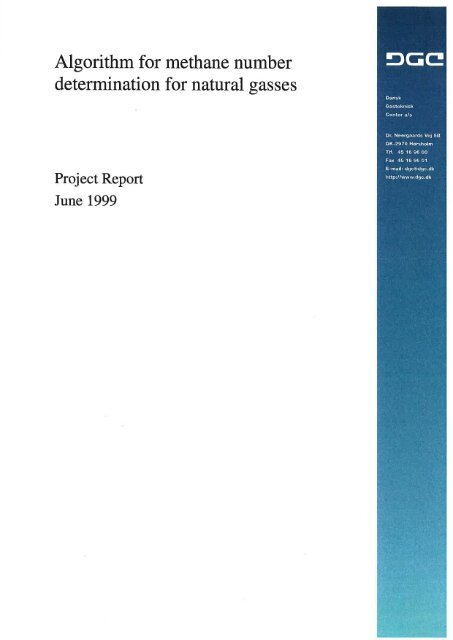
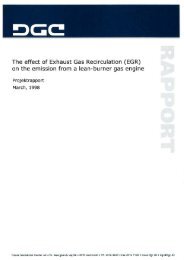

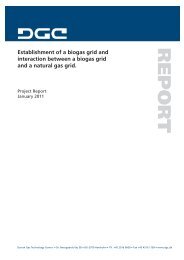
![Hybrid heating systems and smart grid [PDF] - Danish Gas ...](https://img.yumpu.com/46620218/1/184x260/hybrid-heating-systems-and-smart-grid-pdf-danish-gas-.jpg?quality=85)
